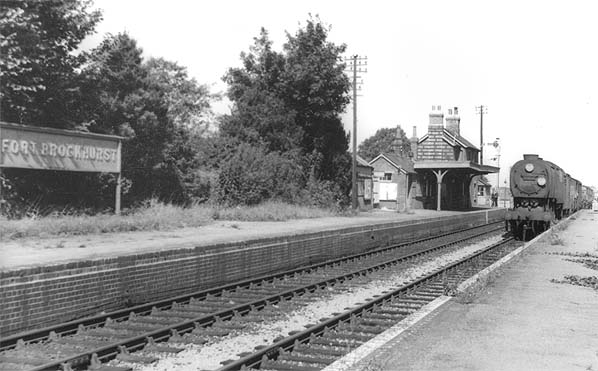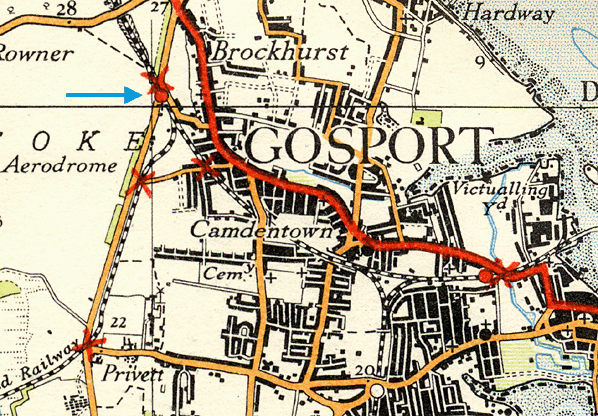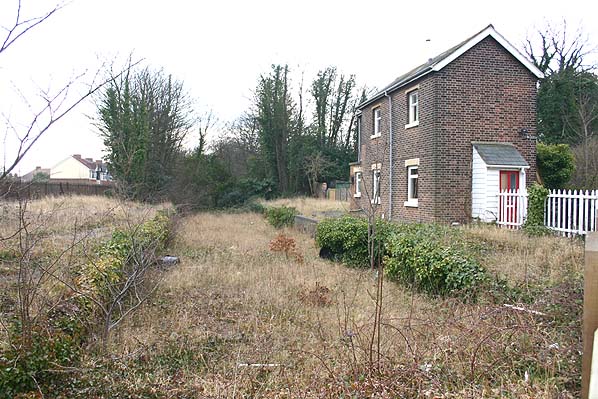|
Notes: The station was opened as Brockhurst but was renamed
Fort Brockhurst on 17th November 1893 to avoid confusion with
Brockenhurst Station west of Southampton. The station had
two platforms with a brick-built stationmasters house on the
up platform and a wooden waiting shelter on the down platform.
With the opening of the Lee-on-the-Solent branch in 1894 the
station became a junction with an additional platform for
branch trains sited behind the up platform. Although there
was a physical connection between the branch and the main
line in the form of a siding the branch was operated as a
shuttle with few through trains. Where through trains did
run passengers had to leave the train at Fort Brockhurst while
the train was shunted onto the branch. Much of the traffic
handles was of naval or military origin.
BRIEF HISTORY OF THE FAREHAM
- GOSPORT LINE
A railway to Gosport was first promoted in 1836 as part of
a plan by the London and Southampton Railway to connect Portsmouth
to London. There was strong opposition from local residents
to the building of a branch line into Portsmouth for a line
that was destined for Southampton, such was the animosity
between the two towns. Instead it was proposed that the line
should be built to Gosport from where there was a short ferry
journey to Portsmouth. The plan was dropped but was revived
two years by the London and South Western Railway (LSWR) who
had taken over the London & Southampton. The proposed
terminus was to be just short of the town centre as Gosport
was a fortified town and the Commanding Officer refused to
allow the walls to be breached to bring the railway closer
to the town centre.
The line opened on 29th November 1841. The terminus at Gosport
was designed by William Tite in an Italianate classic tradition
and finished with Tuscan columns with Corinthian capitals
and an overall 'trainshed' roof. The station was first used
by the Royal Family on 8th October 1843 when Prince Albert
arrived at Gosport by train to greet the King Louis - Phillipe
of France. Queen Victoria came to the station six days later
when she accompanied the King on his return to France. The
following year the Queen purchased the Osborne Estate on the
Isle of Wight and the Clarence Victualing Yard at Gosport
was her favoured point of departure rather than Portsmouth
or Southampton. Shortly afterwards Prince Albert and the LSWR
agreed to build a 605 yard extension from Gosport through
the ramparts of the Gosport Lines to a new station closer
to the pier; Gosport Clarence Yard Station (also known as
Royal Victoria Station) opened on 13th September 1845.
The railway and the station were very busy in the middle
part of the 19th century, particularly with the carriage of
coal and other freight. However the opening of a direct service
from London to Portsmouth in 1847 began to have a heavy impact
on Gosport. An intermediate station at Brockhurst was opened
on 1st November 1865 to accommodate the troops occupying the
forts at the north end of the town.
By 1900 passenger numbers were in decline due in part to
the competition from street tramways but with the coming of
WW1 rail traffic quickly improved with supplies to and from
the Royal Clarence Yard and large numbers of troop movements
including the transportation of the wounded soldiers to Haslar
Hospital in Gosport.
After the war, the line was again in decline and in 1934
the twin track to Fareham was singled leaving only a passing
loop at Brockhurst; a rubber tyred, petrol engine, rail
bus was introduced in 1937 as a further economy measure. Despite
the lack of passengers, goods traffic on the line remained
heavy and was increasing up to the start of WW2. During the
war the branch once again saw increased military activity
including supplies, hospital trains and trains carrying prisoners
of war on their way to the local internment camp. With the
end of the hostilities in 1945 the future of the line was
soon in doubt with closure to passengers coming on 6th June
1953. Freight traffic continued until 30th January 1969 when
final closure came with only the northern section of the line
serving the Royal Naval stores depot at Bedenham being retained;
this remains in use today. The section of line between Fort
Brockhurst and the outskirts of Gosport has now been turned
into a public footpath and cycleway.
Further reading: The Railways of Gosport by Kevin Robertson
- Kingfisher 1986
ISBN 0 946184 25 9 (out of print)
Branch
Lines around Gosport by Vic. Mitchell & Keith. Smith
- Middleton Press 1991
ISBN 0 906520 36 3
For other stations on the
Fareham - Gosport branch click on the station name: Fareham,
Gosport & Gosport
Clarence Yard
For other stations on the
Lee-on-the-Solent branch click on the station name: Fort
Gomer Halt, Browndown
Halt, Elmore
Halt,
Lee-on-the-Solent
See also the Stokes
Bay and Gosport
Road & Alverstoke
|



old3.jpg)

 Home
Page
Home
Page
